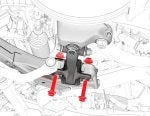The control arm of my Model 3's front wheel just came completely off without any incident. And the Tesla Service Center is stating I will need to pay out of pocket because it's outside my "Basic Vehicle Warranty" (which just expired a couple of months ago). It just feels like I am being asked to pay for a defect (bad build quality) that wasn't caused by me. It doesn't quite make sense.
I have been driving my Model 3 without ANY incident/accident since 2018. The only maintenance I've ever had was a CPU upgrade for FSD. Fast forward to this morning. While backing out of my garage, I heard a strange squeaky noise from the front wheel area. It was then followed by a huge "BAM!" as I started to turn my steering wheel. By then, the vehicle felt "stuck" as if something was preventing the car from moving. Upon inspecting the left front wheel, I noticed the control arm just fell off and was dragging on the ground!!! What?! I've never seen this happen by itself to a car without any incident.
So I scheduled a service visit via Tesla mobile app and was informed that I will need to pay out of pocket to tow my car to the service center. Not only that, they are now saying I will also need to pay out of pocket for the repair since my "Basic Vehicle Warranty" has expired (and Drive Unit Warranty doesn't cover it). The final cost will depend on what they find upon further inspection.
My understanding is that the control arm defect is a known issue (though my VIN isn't on Tesla's recall list). I would understand I need to pay out of pocket for control arm repair IF I had an accident. BUT this just happened by itself without any reason. So basically, I'm being told to pay for an issue that wasn't caused by me. It just doesn't make sense. Not sure if this has happened to anyone.
![Image]()
I have been driving my Model 3 without ANY incident/accident since 2018. The only maintenance I've ever had was a CPU upgrade for FSD. Fast forward to this morning. While backing out of my garage, I heard a strange squeaky noise from the front wheel area. It was then followed by a huge "BAM!" as I started to turn my steering wheel. By then, the vehicle felt "stuck" as if something was preventing the car from moving. Upon inspecting the left front wheel, I noticed the control arm just fell off and was dragging on the ground!!! What?! I've never seen this happen by itself to a car without any incident.
So I scheduled a service visit via Tesla mobile app and was informed that I will need to pay out of pocket to tow my car to the service center. Not only that, they are now saying I will also need to pay out of pocket for the repair since my "Basic Vehicle Warranty" has expired (and Drive Unit Warranty doesn't cover it). The final cost will depend on what they find upon further inspection.
My understanding is that the control arm defect is a known issue (though my VIN isn't on Tesla's recall list). I would understand I need to pay out of pocket for control arm repair IF I had an accident. BUT this just happened by itself without any reason. So basically, I'm being told to pay for an issue that wasn't caused by me. It just doesn't make sense. Not sure if this has happened to anyone.

















